| Designation: | BRM-3K Rys |
 |
|---|---|---|
| Manufacturer: | AO Rubtsovsk Mashine Building Plant | |
| Product type: | Armoured Vehicles | |
| Name: | Reconnaissance Vehicle |
The BRM-3K CRV is intended to perform battlefield and artillery positions reconnaissance for ground forces and coastal defence units in any weather conditions.
Main missions are ground target acquisition, identification and coordinate measurement as well as target engagement.
Navigation and communications aids ensure continuous direction finding and radio links at a range of 100 to 350 km.
The CRV uses engine, gear and water jets of the BMP-3 IFV retaining reliability, cross-country manoeuvrability and combat survivability of the latter.
The built-in armament comprises 30 mm automatic gun and 7.62 mm coaxial machine gun. Provision is made for the ATGM system, 6 assault rifles and 15 hand grenades.
The crew is protected against bullets and projectiles by armour steel hull and turret, and against WMD effects by NBC system.
In 1993, it was revealed that a new version of the Russian BMP-3 Infantry Combat Vehicle (ICV) had been built specifically for the battlefield reconnaissance role under the provisional designation of Model 501.
Early in 1995, it was disclosed that this vehicle is referred to as the BRM combat reconnaissance vehicle in the Russian Army, or the Lynx (Rys). It is also known as the BMP-3K.
The chassis of the BRM combat reconnaissance vehicle is provided by the Kurgan Machine Construction Plant, which is the prime contractor for the chassis, while the systems integrator is the PO Rubtsovskiy Machine Building Plant.
The role of the BRM combat reconnaissance vehicle is to undertake battlefield and artillery reconnaissance for ground troops and coastal units of the navy by day and night and under all weather conditions.
The BRM vehicle can carry out the following missions:
(1) Surveillance of the terrain, search, detection and identification of the ground (surface), fixed, moving and concealed targets
(2) Determination of target rectangular co-ordinates within 360° with an accuracy of 20 m
(3) Continuous computation of navigational data and indication of the directional angle to the assigned point of destination
(4) Round-the-clock radio communications at a range of 100 km whilst moving and up to 350 km when stationary (5) Establishment of an observation post at up to 500 m from the BRM vehicle by means of wire communication or up to 6 km by means of a portable UHF station
(6) Engaging air and land targets while the BRM is stationary or moving under both day and night conditions.
Externally, the BRM reconnaissance vehicle is very similar to the standard BMP-3 ICV which entered service with the Russian Army some years ago and is now also used by Cyprus, Kuwait, South Korea and the United Arab Emirates (Abu Dhabi).
The main external differences include only two firing pons in the rear troop compartment, deletion of the two (one either side) bow-mounted 7.62 mm PKT machine guns and removal of the 100 mm 2A70 rifled gun which fires conventional ammunition as well as the 100 mm 9M117 Bastion laser-guided missile.
The new reconnaissance vehicle retains the three crew seats and hatches at the front of the vehicle with the centre one being for the driver. There appear to be additional observation devices over the frontal arc in the forward part of the hull and a stowage box on the left side of the hull just above the track guard.
The commander and gunner, who also operate the turret-mounted electro-optical devices, are seated in the turret, with the sixth crew member probably being seated to the rear of the turret in the troop compartment to operate the battlefield surveillance radar.
The six-man crew consists of the reconnaissance group commander, vehicle commander, gunner, driver/mechanic, navigator/computer operator and wireless operator.
The fire-control system installed in the BRM includes the BPK2-42 periscopic combined day/night sight, PPB-2 periscopic monocular sight, 2E52-1 armament stabiliser and the BETs-088 control system. As the 100 mm 2A70 gun of the BMP-3 is removed there is no missile laser guidance system for the BRM vehicle.
Main armament of the BRM is the dual-feed 30 mm 2A72 cannon which can engage armoured targets at a range of 1,500 to 2,000 m and helicopters out to a range of 4,000 m and is fully stabilised.
Cyclic rate of fire of the 30 mm 2A72 cannon is 300 rds/min and three types of ammunition can be fired, API, HE-I and HE-T.
Mounted coaxially to the left of the 30 mm cannon is the standard 7.62 mm PKT machine gun with a practical rate of fire of 250 rds/min and a maximum effective range of 1,500 m.
Like the BMP-3 ICV, the new reconnaissance variant has two banks of three 81 mm electrically operated smoke grenade launchers covering the frontal arc, although these are positioned lower down the turret front than on the original BMP-3.
Turret traverse is probably the same as the standard BMP-3 - through a full 360°, with weapon elevation from -5 to +60°. Turret traverse and weapon elevation are all-electric with manual controls for emergency use.
Equipment installed to enable the vehicle to carry out its specialised reconnaissance role includes the mast-mounted 1RL-133-1 battlefield surveillance radar, which can be retracted into the vehicle when not operating; the 1PN71 thermal night observation device; the 1PN61 night observation device; and the ID14 periscopic laser range-finder.
The electro-optical devices are mounted on either side of the turret and, when not being used, the optics are covered by a hinged shutter that opens to the left.
The 1D14 periscopic laser range-finder has a magnification of x 7.3 and x 18 and a maximum range of 25,000 m. This laser is mounted on a turntable and can be used by the vehicle commander for reconnaissance purposes with an arc of 60° regardless of the position of the turret.
The 1PN61 active pulse night vision device with laser illuminator has a magnification of x 7 and a range of 1,500 m in the passive mode and 3,000 m in the active mode. This is mounted externally on the right side of the turret.
The 1PN71 thermal observation device operates in the 8 to 14 |im waveband and has a magnification of x 3.7 and x 11.5 and maximum target identification range is 3,000 m. This is mounted externally on the left side of the turret.
The 1RL-133-1 radar detects vehicles out to a range of 8,000 to 10,000 m and people out to a range of 4,000 m, with the actual ranges depending on the terrain. The radar can be elevated to a height of 1 m and traversed 240° left and right regardless of the turret position.
It is also fitted with the latest TNA-4-6 navigation device, 1T129 coordinator and the 1G50 gyrocompass to enable it to determine quickly its own position on the battlefield.
Communications equipment fitted includes R-163-50U, R-163-50K and R-163-10U radios plus a 1V520 electronic computer. Information would normally be collated in the vehicle and then transmitted to the next chain of command.
A 4 kW generator is provided in the rear of the vehicle to allow the electronic equipment to be operated with the main engine shut down.
If required, the vehicle can be fitted with additional reconnaissance equipment to enable an observation post to be established up to 6 km away from the base vehicle.
Standard equipment includes a fire detection and suppression system and an NBC system. The vehicle is also fully amphibious, being propelled in the water by two water-jets mounted one either side at the rear. Before entering the water the trim vane is erected at the front of the vehicle and the bilge pumps activated.
Weapons carried for use by the crew of the BRM include six assault rifles and 15 hand grenades. An ATGW system for dismounted use can be carried.
Prototype. May be in low-rate production. There are no known exports of this system.
|
||||||||||||||||||
|
|||||||||||||||||||||
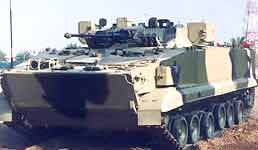 |
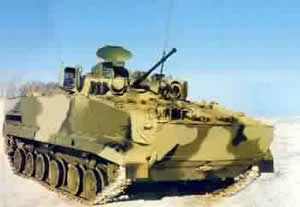 |
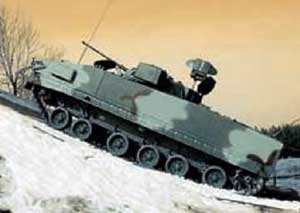 |
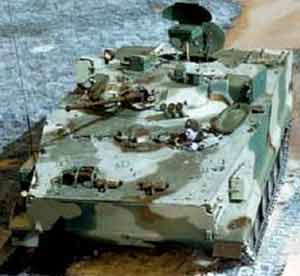 |
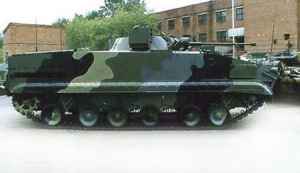 |
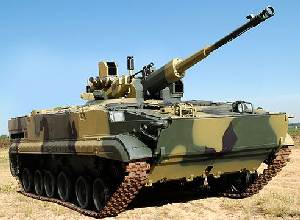 |
